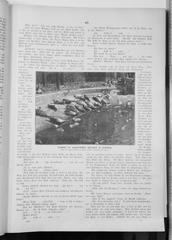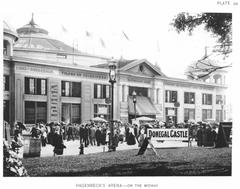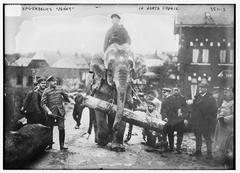
Tierpark Hagenbeck: Visiting Hours, Tickets, and Guide to Hamburg’s Historic Zoo
Date: 14/06/2025
Introduction
Tierpark Hagenbeck, located in Hamburg’s Stellingen district, is not only one of Germany’s most renowned zoological parks but also a global pioneer in modern zoo design. Established in 1907 by Carl Hagenbeck, the zoo revolutionized animal exhibition with its barless, naturalistic enclosures, setting a standard adopted by zoos worldwide. This comprehensive guide covers Tierpark Hagenbeck’s history, significance, visiting hours, ticket options, accessibility, conservation initiatives, special events, and nearby historical attractions—equipping you with all you need for an enriching experience in Hamburg.
Table of Contents
- Introduction
- History and Founding of Tierpark Hagenbeck
- Innovations in Zoo Design
- Family Legacy and Notable Figures
- Controversial History: Ethnological Exhibitions
- War, Reconstruction, and Modernization
- Conservation, Education, and Scientific Impact
- Visitor Information
- Influence on Modern Zoos
- Frequently Asked Questions (FAQ)
- Conclusion
- References
History and Founding of Tierpark Hagenbeck
Tierpark Hagenbeck’s roots trace back to 1848, when Claus Gottfried Karl Hagenbeck began importing and displaying exotic animals in Hamburg (messybeast.com). His son, Carl Hagenbeck, expanded this venture, becoming a leading animal trader by the late 19th century. Carl’s vision materialized in 1907 when the modern Tierpark Hagenbeck opened in Hamburg-Stellingen, introducing the world’s first open-air, barless zoo (hagenbeck.de; britannica.com).
Carl patented the “fenceless zoo” concept in 1896, using moats and landscaping to separate animals from visitors, fundamentally changing animal welfare and public engagement in zoos (dw.com).
Innovations in Zoo Design
Hagenbeck’s innovative approach prioritized animal welfare and visitor immersion. Instead of cages, animals were displayed in expansive, naturalistic habitats, grouped geographically rather than taxonomically, and separated from visitors by invisible moats and panoramic landscapes (hagenbeck.de). Early attractions like the Nordland Panorama set a standard for future zoos in Chicago, Detroit, and Paris (britannica.com; dw.com).
Family Legacy and Notable Figures
After Carl’s death in 1913, his sons Heinrich and Lorenz Hagenbeck continued the park’s development, expanding its facilities and establishing the Circus Carl Hagenbeck. The Hagenbeck family has maintained private ownership and management through six generations, preserving the park’s distinctive blend of innovation and tradition (hagenbeck.de; dw.com).
Controversial History: Ethnological Exhibitions
A significant and controversial aspect of Hagenbeck’s history involves the staging of “Völkerschauen” (ethnological exhibitions or “human zoos”), where people from colonized regions were displayed in constructed environments (contestedhistories.org; fink.hamburg). These exhibitions, reflecting colonial attitudes, are now widely condemned for their racism and exploitation. Today, the zoo acknowledges this legacy and participates in ongoing public discourse and critical reflection.
War, Reconstruction, and Modernization
Tierpark Hagenbeck was heavily damaged during World War II, with about 70% destroyed in air raids. The Hagenbeck family led a successful reconstruction, expanding the park and introducing modern enclosures, including advanced elephant habitats. In 1997, the park was recognized as a cultural monument, and further modernizations followed, such as the opening of the Tropen-Aquarium in 2007 (hagenbeck.de).
Conservation, Education, and Scientific Impact
Tierpark Hagenbeck is home to over 1,850 animals from more than 200 species (hagenbeck.de). The park participates in international breeding programs for endangered species like the Asian elephant, Siberian tiger, and Przewalski’s horse (factsgem.com). Its Tropen-Aquarium houses more than 350 aquatic and terrestrial species, supporting both research and educational programs (hamburg.de).
Educational initiatives include guided tours, school workshops, and conservation-themed events, such as “Dschungel-Nächte” (Jungle Nights), blending entertainment with environmental awareness (hagenbeck.de).
Visitor Information
Visiting Hours
- Tierpark Hagenbeck: Open daily, typically 9:00 AM–6:00 PM (seasonal variations may apply).
- Tropen-Aquarium: Usually 9:00 AM–7:00 PM.
- Always check the official website for current hours.
Ticket Prices
- Adults: Approx. €24
- Children (4–16): Approx. €16.50
- Discounts: Available for seniors, students, and groups
- Combination tickets: Zoo + Aquarium at a reduced rate
- Annual passes and family tickets: Available
- Tickets can be purchased online or at the entrance.
Accessibility
- Barrier-free paths, ramps, and accessible restrooms.
- Wheelchair and stroller rentals available.
- Service animals permitted; staff can assist guests with special needs.
Getting There
- Public Transport: U-Bahn line U2 to “Hagenbecks Tierpark” station; several bus lines also stop nearby.
- Car: Parking garage on-site.
- See hamburg-travel.com for travel tips.
Nearby Attractions
- Speicherstadt: UNESCO-listed warehouse district
- St. Michael’s Church
- Planten un Blomen Park
- Hamburg’s historic harbor and museums are easily accessible by public transport
Guided Tours & Special Events
- Regular guided tours (including themed wildlife and history tours)
- Seasonal events such as “Jungle Nights” and holiday programs
- Educational workshops for children and schools
Influence on Modern Zoos
Tierpark Hagenbeck’s naturalistic, barless enclosures, social animal groupings, and visitor-focused design principles have shaped the philosophy and architecture of modern zoos worldwide (dw.com; britannica.com). The park remains a benchmark for humane animal care and immersive visitor experiences.
Frequently Asked Questions (FAQ)
Q: What are Tierpark Hagenbeck’s opening hours?
A: Usually 9:00 AM–6:00 PM daily; check the official website for updates.
Q: How do I buy tickets?
A: Tickets are available online and at the entrance. Combination tickets and discounts are offered.
Q: Is the park wheelchair accessible?
A: Yes, barrier-free access and accessible restrooms are provided.
Q: Are pets allowed?
A: No, to protect zoo animals, pets are not permitted.
Q: Are guided tours available?
A: Yes, regular guided tours and educational events are offered.
Q: What are the main attractions?
A: Highlights include the Eismeer (Arctic Panorama), African Savannah, Tropen-Aquarium, Elephant Enclosure, and interactive animal feedings.
Conclusion
Tierpark Hagenbeck is more than a zoo—it’s a cultural and architectural landmark, a leader in conservation, and a family-friendly destination. Its unique blend of historic innovation, active conservation programs, and modern visitor amenities make it a must-visit in Hamburg. For up-to-date information, tickets, and event schedules, visit the official Tierpark Hagenbeck website.
Enhance your experience by downloading the Audiala app for audio guides and insider tips. Combine your visit with Hamburg’s historic sites for a truly memorable itinerary.
Visuals
Related Hamburg Guides
References
- Tierpark Hagenbeck: Tickets, Hours, History, and Attractions in Hamburg, 2024
- Discover Tierpark Hagenbeck: Architecture, Animal Welfare, and Visitor Information for an Unforgettable Hamburg Experience, 2024
- Tierpark Hagenbeck Visiting Hours, Tickets, and Attractions in Hamburg, 2024
- Tierpark Hagenbeck: Visitor Guide, Conservation Efforts & Ethical Insights, 2024
- Carl Hagenbeck: The Inventor of the Modern Animal Park, 2019, Deutsche Welle
- Carl Hagenbeck Zoo in Hamburg - Contested Histories, 2021
- Völkerschau bei Hagenbeck erinnert an die Grausamkeiten, 2021, FINK Hamburg
- Zoological Garden of Hamburg, Wikipedia
- Tierpark Hagenbeck Historical and Architectural Features, The Passenger, 2019






































































































